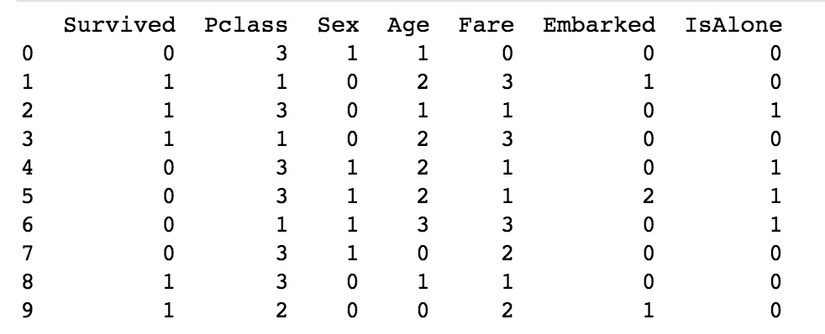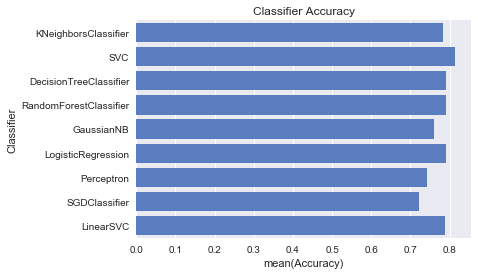Case Study: Solving Kaggle's Titanic machine learning competition
Bài đăng này đã không được cập nhật trong 4 năm
 In my previous article, I wrote about example of using marchine learning algorithms via
In my previous article, I wrote about example of using marchine learning algorithms via scikit-learn. However, the Iris dataset dataset has already prepare for learning. In this article, we mainly focus on data preparation before we can fit it into our learning model. What is data preparation?
What is data preparation?
Believe me or not, the machine learning engineer spend 80% of their times for preparing data, and 20% for training and improving the model. The way of machine learning work is simple. It learns from the old data and then it predict the output for a given input base on the previous example. Therefore, it is critical that you feed them the right data for the problem you want to solve. Even if you have good data, you need to make sure that it is in a useful scale, format and even that meaningful features are included.
Why don't we raw data to train our model? why we need to prepare our data? Because not all features in our dataset are nacessary to address the problem, and some features might have missing value, strong in wrong format. When we include those features to our training, it can cause problems to our generalization. So we need to process those field first.
In this post we are going to use titanic dataset train.csv from Kaggle. Because it is a raw data, so we need to prepare first.
Data Preparation Process
There are three for data preparation:
- Select Data
- Process Data
- Transform Data
To learn more about the definition of data preparation click here
First of all, we will use some libraries: sklearn for machine learnig algorithms, pandas, numpy for handling the data, and seaborn, matplotlib for our data visualization
# data analysis and wrangling
import pandas as pd
import numpy as np
import random as rnd
# visualization
import seaborn as sns
import matplotlib.pyplot as plt
# machine learning
from sklearn.model_selection import StratifiedShuffleSplit
from sklearn.metrics import accuracy_score, log_loss
from sklearn.linear_model import LogisticRegression
from sklearn.svm import SVC, LinearSVC
from sklearn.ensemble import RandomForestClassifier
from sklearn.neighbors import KNeighborsClassifier
from sklearn.naive_bayes import GaussianNB
from sklearn.linear_model import Perceptron
from sklearn.linear_model import SGDClassifier
from sklearn.tree import DecisionTreeClassifier
Now, let's start prepare our titanic dataset and learn from it.
1. Select Data and Processs Data
Select Data: is concerned with selecting the subset of all available data that you will be working with. The process of selecting data are used to identify the relevant and irrelevant feature. Preprocess Data: After you have selected the data, you need to consider how you are going to use the data. This preprocessing step is about getting the selected data into a form that you can work. Three common data preprocessing steps are formatting, cleaning and sampling.
First, we need read our dataset, and try to understand the given information from data itself.
train_df = pd.read_csv('train.csv')
print(train_df.columns.values)
#['PassengerId' 'Survived' 'Pclass' 'Name' 'Sex' 'Age' 'SibSp' 'Parch' 'Ticket' 'Fare' 'Cabin' 'Embarked']
train_df.info()
#<class 'pandas.core.frame.DataFrame'>
#RangeIndex: 891 entries, 0 to 890
#Data columns (total 12 columns):
#PassengerId 891 non-null int64
#Survived 891 non-null int64
#Pclass 891 non-null int64
#Name 891 non-null object
#Sex 891 non-null object
#Age 714 non-null float64
#SibSp 891 non-null int64
#Parch 891 non-null int64
#Ticket 891 non-null object
#Fare 891 non-null float64
#Cabin 204 non-null object
#Embarked 889 non-null object
#dtypes: float64(2), int64(5), object(5)
#memory usage: 83.6+ KB
Let's preview our data
print(train_df.head())
#PassengerId Survived Pclass Name Sex Age SibSp Parch Ticket Fare Cabin Embarked
#1 0 3 Braund, Mr. Owen Harris male 22.0 1 0 A/5 21171 7.2500 NaN S
#2 1 1 Cumings, Mrs. John Bradley (Florence Briggs Th... female 38.0 1 0 PC 17599 71.2833 C85 C
#3 1 3 Heikkinen, Miss. Laina female 26.0 0 0 STON/O2. 3101282 7.9250 NaN S
#4 1 1 Futrelle, Mrs. Jacques Heath (Lily May Peel) female 35.0 1 0 113803 53.1000 C123 S
#5 0 3 Allen, Mr. William Henry male 35.0 0 0 373450 8.0500 NaN S
print(train_df.tail())
#PassengerId Survived Pclass Name Sex Age SibSp Parch Ticket Fare Cabin Embarked
#887 0 2 Montvila, Rev. Juozas male 27.0 0 0 211536 13.00 NaN S
#888 1 1 Graham, Miss. Margaret Edith female 19.0 0 0 112053 30.00 B42 S
#889 0 3 Johnston, Miss. Catherine Helen "Carrie" female NaN 1 2 W./C. 6607 23.45 NaN S
#890 1 1 Behr, Mr. Karl Howell male 26.0 0 0 111369 30.00 C148 C
#891 0 3 Dooley, Mr. Patrick male 32.0 0 0 370376 7.75 NaN Q
Now, let's investigate our features one by one:
- Pclass:
As you can see this feature has some impact to the output. So we keep itprint(train_df[['Pclass', 'Survived']].groupby(['Pclass']).mean()) #Pclass Survived #1 0.629630 #2 0.472826 #3 0.242363 - Name: because name has no association survival chance, so we do not need it.
- Sex:
Base on information above, we saw that weman has a survival chance high, so we need this feature for our learning.print(train_df[['Sex', 'Survived']].groupby(['Sex']).mean()) #Sex Survived #female 0.742038 #male 0.188908 - Age:
We have some missing values in this feature. Since it a number we can fill the missing value from a random number between (mean -std) and (mean + std), and we categorize age into 5 range.
for dataset in full_data: age_avg = dataset['Age'].mean() age_std = dataset['Age'].std() dataset['Age'] = dataset['Age'].fillna(np.random.randint(age_avg - age_std, age_avg + age_std)) dataset['Age'] = dataset['Age'].astype(int) print(train_df['Age'].describe()) #count 891.000000 #mean 31.928171 #std 13.773505 #min 0.000000 #25% 22.000000 #50% 32.000000 #75% 41.000000 #max 80.000000 #Name: Age, dtype: float64 train_df['CategoricalAge'] = pd.cut(train_df['Age'], 5) print(train_df[['CategoricalAge', 'Survived']].groupby(['CategoricalAge']).mean()) #CategoricalAge Survived #(-0.08, 16.0] 0.550000 #(16.0, 32.0] 0.370690 #(32.0, 48.0] 0.349862 #(48.0, 64.0] 0.434783 #(64.0, 80.0] 0.090909 - SibSp and Parch:
With the number of siblings/spouse and the number of children/prarents we can create a new feature class Family Size.
for dataset in full_data: dataset['FamilySize'] = dataset['SibSp'] + dataset['Parch'] + 1 print(train_df[['FamilySize', 'Survived']].groupby(['FamilySize']).mean()) #FamilySize Survived #1 0.303538 #2 0.552795 #3 0.578431 #4 0.724138 #5 0.200000 #6 0.136364 #7 0.333333 #8 0.000000 #11 0.000000 # Let check whether they are alone in the ship or not. for dataset in full_data: dataset['IsAlone'] = 0 dataset.loc[dataset['FamilySize'] == 1, 'IsAlone'] = 1 print(train_df[['IsAlone', 'Survived']].groupby(['IsAlone']).mean()) #IsAlone Survived #0 0.505650 #1 0.303538 - Ticket: The change of survive is not depent on ticket number, so we no need this feature.
- Fare:
There is some missing value in these feature, and we will replace it with the median. Then we can categorize it into 4 ranges.
for dataset in full_data: dataset['Fare'] = dataset['Fare'].fillna(dataset['Fare'].median()) train_df['CategoricalFare'] = pd.qcut(train_df['Fare'], 4) print(train_df[['CategoricalFare', 'Survived']].groupby(['CategoricalFare']).mean()) #CategoricalFare Survived #(-0.001, 7.91] 0.197309 #(7.91, 14.454] 0.303571 #(14.454, 31.0] 0.454955 #(31.0, 512.329] 0.581081 - Cabin: The cabin number cannot determine the survival chance, so we do not need to feature.
- Embarked:
There is some missing value in these feature, and we will fill with the most occurred value in this feature ('S).
for dataset in full_data: dataset['Embarked'] = dataset['Embarked'].fillna('S') print(train_df[['Embarked', 'Survived']].groupby(['Embarked']).mean()) #Embarked Survived #C 0.553571 #Q 0.389610 #S 0.339009
3. Transform Data
Transform data is the process transformations our dataset's feature into format where machine can learn from. This step is also referred to as feature engineering. Let's transform our dataset's features:
for dataset in full_data:
# Mapping Sex
dataset['Sex'] = dataset['Sex'].map({'female': 0, 'male': 1}).astype(int)
# Mapping Embarked
dataset['Embarked'] = dataset['Embarked'].map({'S': 0, 'C': 1, 'Q': 2}).astype(int)
# Mapping Fare
dataset.loc[dataset['Fare'] <= 7.91, 'Fare'] = 0
dataset.loc[(dataset['Fare'] > 7.91) & (dataset['Fare'] <= 14.454), 'Fare'] = 1
dataset.loc[(dataset['Fare'] > 14.454) & (dataset['Fare'] <= 31), 'Fare'] = 2
dataset.loc[dataset['Fare'] > 31, 'Fare'] = 3
dataset['Fare'] = dataset['Fare'].astype(int)
# Mapping Age
dataset.loc[ dataset['Age'] <= 16, 'Age'] = 0
dataset.loc[(dataset['Age'] > 16) & (dataset['Age'] <= 32), 'Age'] = 1
dataset.loc[(dataset['Age'] > 32) & (dataset['Age'] <= 48), 'Age'] = 2
dataset.loc[(dataset['Age'] > 48) & (dataset['Age'] <= 64), 'Age'] = 3
dataset.loc[ dataset['Age'] > 64, 'Age'] = 4
dataset['Age'] = dataset['Age'].astype(int)
# Feature Selection: remove unnacessary field
drop_features = ['PassengerId', 'Name', 'Ticket', 'Cabin', 'SibSp', 'Parch', 'FamilySize']
train_df = train_df.drop(drop_features, axis=1)
train_df = train_df.drop(['CategoricalAge', 'CategoricalFare'], axis=1)
test_df_droped = test_df.drop(drop_features, axis = 1)
trainingSet = train_df.values
testingSet = test_df_droped.values
# let print the sample of our final prcessing
print (train_df.head(10))

Here, we got the dataset where we can fit into our learning model, and it's time to train our learning model.
Apply Learning Algorithms
After finish preparing our data, it's time to apply learning algorithms to train our model same as what we did in previous post.
# Classifier Comparision
classifiers = [
KNeighborsClassifier(3),
SVC(probability=True),
DecisionTreeClassifier(),
RandomForestClassifier(),
GaussianNB(),
LogisticRegression(),
Perceptron(),
SGDClassifier(),
LinearSVC()
]
log_cols = ["Classifier", "Accuracy"]
log = pd.DataFrame(columns=log_cols)
sss = StratifiedShuffleSplit(n_splits=10, test_size=0.1, random_state=0)
X = trainingSet[0::, 1::]
y = trainingSet[0::, 0]
acc_dict = {}
for train_index, test_index in sss.split(X,y):
X_train, X_test = X[train_index], X[test_index]
y_train, y_test = y[train_index], y[test_index]
for clf in classifiers:
name = clf.__class__.__name__
clf.fit(X_train, y_train)
train_predictions = clf.predict(X_test)
acc = accuracy_score(y_test, train_predictions)
if name in acc_dict:
acc_dict[name] += acc
else:
acc_dict[name] = acc
for clf in acc_dict:
acc_dict[clf] = acc_dict[clf] / 10.0
log_entry = pd.DataFrame([[clf, acc_dict[clf]]], columns=log_cols)
log = log.append(log_entry)
plt.xlabel('Accuracy')
plt.title('Classifier Accuracy')
sns.set_color_codes("muted")
sns.barplot(x='Accuracy', y='Classifier', data=log, color='b')
And here we got:

Let's predict the given test data and submit the result to kaggle.
model = SVC(probability=True)
model.fit(X, y)
Y_pred = model.predict(testingSet)
submission = pd.DataFrame({
"PassengerId": test_df["PassengerId"],
"Survived": Y_pred
})
submission
submission.to_csv('submission.csv', index=False)
And here the result:

0.77 or 77% not bad, but it not goot enough. With your help on preparing the data we might able improve it, so please put your suggestion in comment belove.
Resources
- source code: https://github.com/RathanakSreang/MachineLearning/blob/master/kaggle/titanic/titanic.ipynb
- dataset: https://www.kaggle.com/c/titanic/data
- https://www.kaggle.com/bgarolera/titanic-data-science-solutions
- https://www.kaggle.com/omarelgabry/a-journey-through-titanic
- https://triangleinequality.wordpress.com/2013/09/08/basic-feature-engineering-with-the-titanic-data/
- http://machinelearningmastery.com/how-to-prepare-data-for-machine-learning/
- Titanic film: https://www.youtube.com/watch?v=cMVi953awHQ
Summary
The key to has a good modeling is to has a good data, and it still better even your learning algorithms is not so good. Therefore, getting good at data preparation will make you a master at machine learning. However, to master the data preparation you need to do a lot of iterations of exploration and analysis. And for data preparing above, if you have any suggestion to improve it please put the comment belove.
All rights reserved